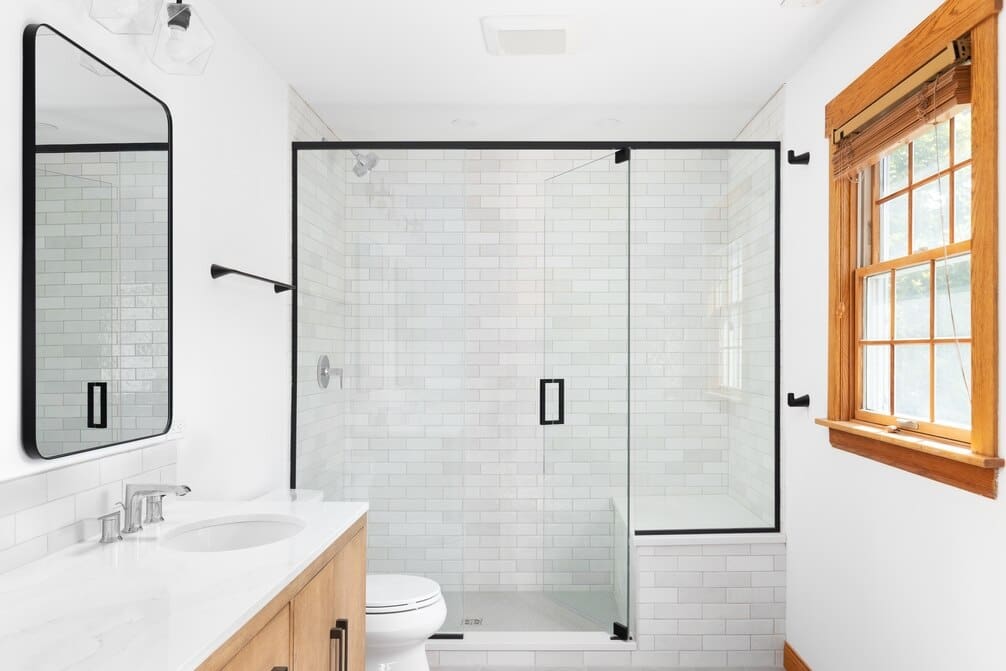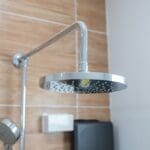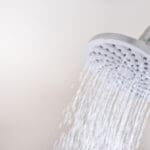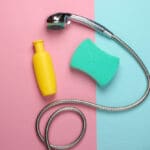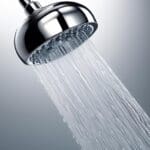Did you know that a leaking shower can waste up to 2,000 gallons of water a year? If you’re facing this issue, it’s not just an annoyance but also an environmental concern. Luckily, fixing your leaking shower head hose can be simpler than you think, and you don’t need to be a plumbing expert to do it.
By following five easy steps, you’ll identify the source of the leak, turn off the water supply, inspect and adjust connections, replace damaged parts, and finally, test and secure the seal to ensure a leak-free shower. This process not only saves water but can also prevent potential water damage to your home.
Stick around to discover how these straightforward steps can help you tackle the problem efficiently and effectively, ensuring a sustainable and hassle-free solution.
Key Takeaways
- Identify the source of the leak by examining the shower head and hose connection.
- Turn off the water supply before inspecting and adjusting connections.
- Replace damaged parts with exact replacements from a hardware store.
- Test for leaks and secure the seal by checking and tightening connections.
Identify the Leak Source
To accurately fix a leaking shower head hose, you’ll first need to identify where the leak is coming from. Start by examining the shower head and hose connection for any signs of leaking, such as water droplets, dampness, or visible cracks. Pay close attention to any water pooling or dripping from the hose connection, as this is a telltale sign. Also, listen for any hissing or whistling sounds that indicate a leak.
Next, check for loose or improperly tightened connections between the shower head and hose. Often, a leaky shower can be fixed by simply tightening these connections. Use a wrench or pliers to ensure everything is snug
Turn Off Water Supply
Before proceeding with repairs, you’ll need to shut off your shower’s water supply or the main water valve to prevent any mishaps. Start by locating the water line specifically for your shower, often found in the boiler room, or identify the main shutoff valve for your home’s water supply. If your home is equipped with separate water lines, use the key provided with your house to turn off the water line for your shower.
Should you not have separate water lines, turn the main shutoff valve. To ensure the water is indeed off, take a moment to turn on a random sink within your home and check if water still flows. This step is crucial to avoid water spilling out while you’re in the midst of fixing a leaky shower or when you slide the shower head off the piping behind.
Inspect and Adjust Connections
After ensuring the water supply is off, inspect and adjust the connections between the shower head, hose, and water supply for any issues. This step is fairly normal in the maintenance process of a home’s water fixtures and can prevent further leaks.
Here’s how to do it effectively:
- Inspect Connections: Look for any loose or damaged parts between the shower head, hose, and water supply. It’s probably dirty, so clean any debris before proceeding.
- Tighten Loose Connections: Use a wrench or pliers to tighten any connections that aren’t secure. A secure fit is essential to prevent water from escaping.
- Replace Damaged Parts: If you find any worn-out couplings or washers, replace them with new ones. Ensure that the replacement parts are compatible with your shower setup.
- Apply Thread Seal Tape: Wrap thread seal tape around the threads of the connection to ensure a watertight seal. This step is crucial for preventing leaks.
Replace Damaged Parts
You’ll need to pinpoint the faulty component causing the problem. This could be anything from a worn-out washer to a broken coupling. Once identified, head to your local hardware store to purchase the exact replacement part needed.
Removing the damaged part requires careful handling to avoid further issues. Ensure the water supply is turned off before you start. Unscrew or unclip the faulty part from the hose, taking note of its placement and how it fits into the assembly.
Installing the new part is straightforward but demands precision. Securely attach the replacement part to the hose, ensuring it’s tightly fixed to prevent future leaks.
Test and Secure Seal
Once you’ve installed the new part, turn on the water supply to test the seal for any leaks. This step is crucial in ensuring the longevity and effectiveness of your repairs. Here’s how to proceed:
- Observe for Leaks: With the water supply on, carefully check around the connections. If there’s even a slight drip, you haven’t quite nailed the seal yet.
- Tighten Connections: Sometimes, all it takes is a little more elbow grease. If you spot a leak, gently tighten the connections. Use adjustable wrenches to avoid damaging the fittings.
- Apply Thread Seal Tape: If leaks persist, turning off the water and applying thread seal tape to the threads can provide an extra layer of protection. This tape creates a more secure and tight seal, reducing the likelihood of future leaks.
- Double-check Everything: Go over all connections and fittings once more to ensure they’re snug and properly secured. This is your final line of defense against leaks.
If, after following these steps, leaks continue, it might be time to seek professional help.
Frequently Asked Questions
How Do You Fix a Leaking Shower Head Hose?
To fix a leaking shower head hose, first identify the leak source, tighten any loose connections, replace damaged washers, clean out debris, and use thread seal tape for a secure fit. It’s straightforward!
How Do I Stop My Shower Head From Leaking?
To stop your shower head from leaking, first identify the leak’s source. Then, turn off the water, tighten connections, and replace damaged parts. Inspect and swap out the hose if needed to fix the leak.
Why Is There a Leak Between My Shower Hose and Head?
Your shower hose and head are likely leaking due to loose or damaged connections, wear from constant use, faulty couplings, high water pressure, or improper installation. Check these areas to identify the issue.
How Do You Fix a Leaking Hose?
To fix your leaking hose, first, identify the leak source. Turn off the water, tighten connections, and replace damaged parts. If the hose is damaged, unscrew the old one and connect a new hose securely.

